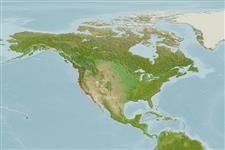>
Acipenseriformes (Sturgeons and paddlefishes) >
Acipenseridae (Sturgeons) > Acipenserinae
Etymology: Acipenser: Latin, acipenser = sturgeon, 1853 (Ref. 45335); transmontanus: The specific name is derived from the Latin acipenser (sturgeon), trans (beyond), and montanus (mountain) (Ref. 27436).
More on author: Richardson.
Environment: milieu / climate zone / depth range / distribution range
экология
морской; пресноводный; солоноватоводный демерсальный; анадромный (Ref. 51243); пределы глубины 1 - 122 m (Ref. 27547). Temperate; 0°C - 23°C (Ref. 1998); 58°N - 24°N, 163°W - 107°W (Ref. 54269)
Eastern Pacific: Alaska Bay to Monterey, California, USA. Landlocked in Columbia River drainage, Montana, and perhaps Lake Shasta in California, USA. Translocated to lower Colorado River, Arizona in USA. Reported from northern Baja California, Mexico (Ref. 2850, 27436).
Length at first maturity / Size / Вес / Возраст
Maturity: Lm 160.0 range ? - ? cm
Max length : 610 cm TL самец/пол неопределен; (Ref. 1998); common length : 21.0 cm TL самец/пол неопределен; (Ref. 12193); наибольший вес (опубликованные данные): 816.0 kg (Ref. 27436); наибольший возраст (опубликованны данные): 104 годы (Ref. 39377)
колючие лучи спинного плавника (общее число) : 0; членистые (мягкие) лучи спинного плавника (общее число) : 44 - 48; членистые (мягкие) лучи анального плавника: 28 - 31. Distinguished by the 2 rows of 4 to 8 bony plates on a midventral line between the anus and anal fin, and about 45 rays in the dorsal fin (Ref. 27547). Gray or brownish above, paler below; fins gray (Ref. 27547). Barbels situated closer to snout tip than to mouth; no obvious scutes behind dorsal and anal fins (Ref. 86798).
Spends most of its time in the sea, usually close to shore (Ref. 27547). Enters estuaries of large rivers and moves far inland to spawn (Ref. 5723). Individuals larger than 48.3 cm feed mainly on fishes; smaller ones feed mainly on chironomids, but also takes small crustaceans, other insects and mollusks (Ref. 1998). Feeding ceases just before spawning (Ref. 1998). Excellent food fish that is sold fresh, smoked or frozen (Ref. 9988). Eggs marketed as caviar (Ref. 1998). In the past, the airbladder was made into isinglass (Ref. 27547).
Adults return to the sea after spawning (Ref. 27547). Spawning frequency interval every 4 years for younger females and every 10-11 years in older females (Ref. 1998).
Page, L.M. and B.M. Burr, 1991. A field guide to freshwater fishes of North America north of Mexico. Houghton Mifflin Company, Boston. 432 p. (Ref. 5723)
Статус Красного Списка МСОП (Ref. 130435: Version 2024-1)
Угроза для людей
Harmless
Использование человеком
рыболовство: коммерческий; аквакультура (рыбоводство): коммерческий; объект спортивного рыболовства: да
дополнительная информация
инструменты
Специальные отчеты
Скачать в формате XML
ресурсы в Интернет
Estimates based on models
Preferred temperature (Ref.
123201): 8.3 - 12.2, mean 9.7 °C (based on 80 cells).
Phylogenetic diversity index (Ref.
82804): PD
50 = 0.5000 [Uniqueness, from 0.5 = low to 2.0 = high].
Bayesian length-weight: a=0.00302 (0.00153 - 0.00597), b=3.19 (3.02 - 3.36), in cm total length, based on LWR estimates for this species & Genus-body shape (Ref.
93245).
Trophic level (Ref.
69278): 3.3 ±0.1 se; based on diet studies.
Generation time: 27.5 ( na - na) years. Estimated as median ln(3)/K based on 1
growth studies.
устойчивость к внешним воздействиям (Ref.
120179): очень низкий, минимальное время удвоения популяции более 14 лет (tm=11-34; tmax=104).
Fishing Vulnerability (Ref.
59153): Very high vulnerability (87 of 100).
Climate Vulnerability (Ref.
125649): Moderate to high vulnerability (48 of 100).
Nutrients (Ref.
124155): Calcium = 8.84 [4.78, 17.65] mg/100g; Iron = 0.244 [0.136, 0.429] mg/100g; Protein = 17.4 [14.8, 20.2] %; Omega3 = 0.293 [0.147, 0.585] g/100g; Selenium = 31.4 [14.7, 69.3] μg/100g; VitaminA = 4.45 [1.29, 16.47] μg/100g; Zinc = 0.377 [0.252, 0.570] mg/100g (wet weight);
